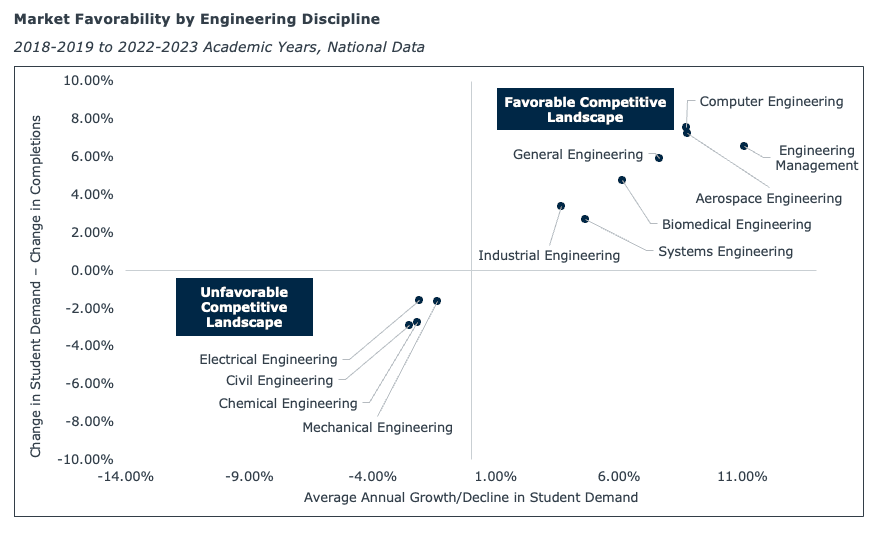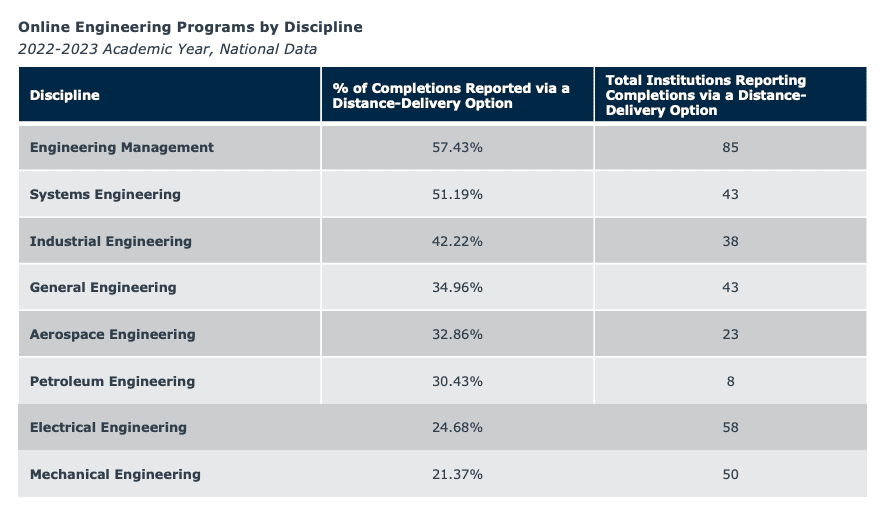Rethinking recruitment for graduate engineering programs
Graduate engineering programs face significant challenges as the second Trump administration’s isolationist policies limit international enrollment. After a nearly 40% increase in international student enrollment in science, engineering, and health programs between 2021 and 2022, nearly 20% of international students in the US were enrolled in engineering programs by 2024. In the wake of new immigration policies, engineering schools will face incredible challenges in managing the fallout.
However, an opportunity lies within this uncertainty, as it becomes necessary to recruit new student populations. In this post, we’ll explore current trends in the graduate engineering landscape and share recommendations on how your school can thrive in the shifting market.
Engineering employer demand is strong across the board
Despite looming threats to the supply of master’s-level engineering students, employer demand for engineers remains strong. According to the U.S. Bureau of Labor Statistics, employment in architecture and engineering occupations is projected to grow faster than the average across all sectors, with median annual wages for engineers substantially higher than those in other fields. And over 42% of professionals in these roles hold advanced degrees, reinforcing the value of continued education.

Labor market trends are a reliable predictor of student interest as adult learners seek to upskill and increase their employability. Emphasize the robust ROI associated with earning an engineering master’s in your program’s marketing to attract students looking to advance their careers.
Mechanical and electrical engineering degree trends underperform other disciplines
While pursuing a master’s-level engineering degree remains a wise choice for students, interest varies significantly among disciplines.
Traditional mechanical and electrical engineering programs have historically dominated both student demand and market need. However, national degree completions in these fields have declined between the 2018-2019 and 2022-2023 academic years, even as the number of institutions offering mechanical engineering programs has increased. These trends suggest students are diversifying their interests into emerging subfields.

New program opportunities exist in fields with favorable competitive landscapes, or fields where growth in student demand outpaces growth in competition on average annually. In contrast, the traditional giants, mechanical and electrical engineering, exist in unfavorable, saturated markets.
The fields with the most favorable competitive landscapes are:
- Computer Engineering
- Engineering Management
- Aerospace Engineering
- General Engineering (usually describing a program with coursework in multiple subjects, typically with concentrations for more specialized study)
- Biomedical Engineering
- Systems Engineering
- Industrial Engineering
Investing in these fields will likely lead to the best results for schools looking to expand their engineering portfolio.
It’s important to note, though, that mechanical and electrical engineering programs remain strong investments for schools launching a school of engineering, as they provide the groundwork and foundational knowledge necessary to develop programs in emerging fields. Additionally, their strong labor markets provide program graduates with a high-value opportunity for career advancement.
Recruit New Grad And Adult Computer Science Students Amid Tech Sector Upheaval
Online audiences will be increasingly important to meet enrollment goals
As international enrollments decline, schools will need to pivot their focus to recruit domestic, often online audiences to maintain and grow their classes. Flexible, online modalities enable schools to attract a broader domestic demographic, including working adults juggling work and family responsibilities.
All engineering disciplines are offered online; however, certain fields are currently better suited for distance delivery. Below, I’ve listed disciplines that have an established online presence, either with a net total of 50 online institutions or having 30% of their total institutions reporting completions via distance-delivery.

Ultimately, disciplines that have an already established online presence and have experienced increasing student demand will likely provide the best opportunities for new program launches. These programs include:
- Engineering Management
- Systems Engineering
- Industrial Engineering
- General Engineering
- Aerospace Engineering
While mechanical and electrical engineering programs remain a stable foundation for engineering schools, exploring these less-saturated disciplines is more likely to yield immediate growth opportunities.
As the graduate engineering landscape shifts and international student populations wane, focused recruitment efforts will become more important. Crafting marketing messages that highlight a program’s ROI and targeting recruitment efforts toward working adults will be essential to attracting a new domestic audience.
However, this is only one piece of the puzzle. EAB’s Strategic Advisory Services team stands ready to assist schools in designing innovative programs, providing in-depth insights into the engineering field, and nurturing prospective students throughout the enrollment funnel. And Appily Advance, EAB’s graduate and adult lead generation solution, can help diversify your lead generation strategy and generate high-intent, right-fit engineering leads. Consider us a resource as you navigate the ever-changing higher ed landscape.

More Blogs

4 questions domestic students will ask before applying to your graduate program

When Grad PLUS disappears: What 8,000+ grad students said about paying for school
